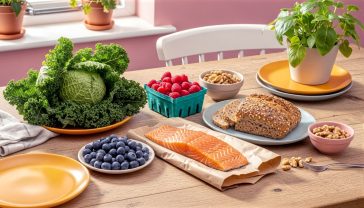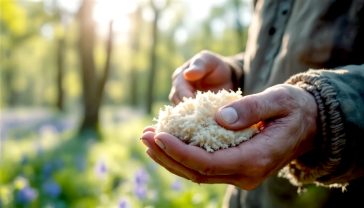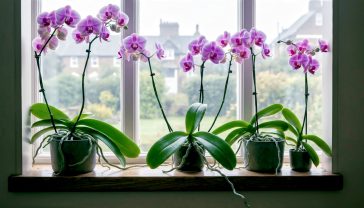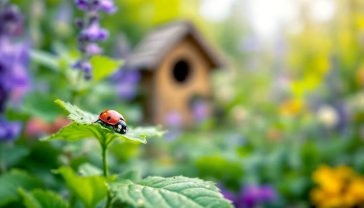Eco-Friendly Garden Design: The Guide to Organic Success
Your definitive guide to eco-friendly garden design in the UK. Learn layouts for organic success, from permaculture to modern cottage gardens, and create a wildlife haven.
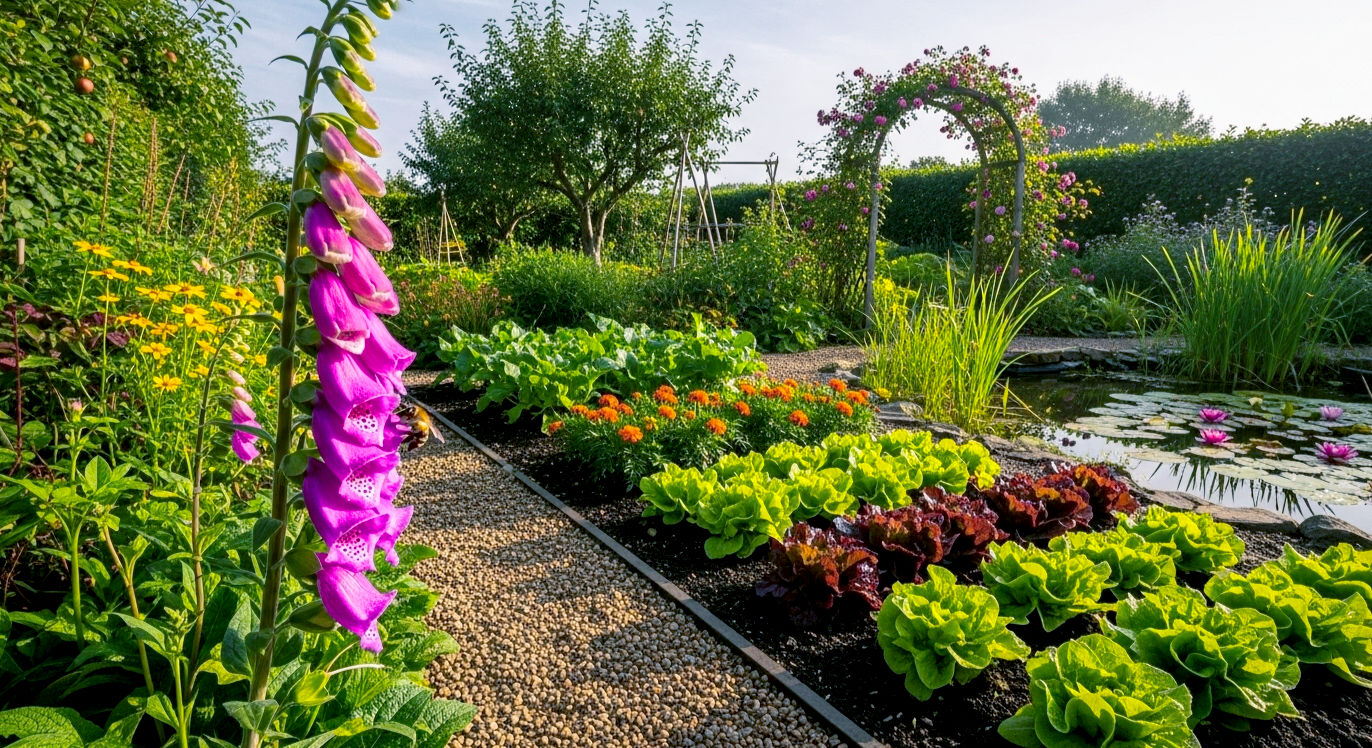
This post may contain affiliate links. If you make a purchase through these links, we may earn a commission at no additional cost to you.
Ever stood by your back door with a cuppa, looking out at your garden and thinking, “It could be… more”? More than just a neat lawn and a few sad-looking petunias. More alive, more useful, more… magical? What if your little patch of Britain could be a buzzing, thriving ecosystem that helps the planet, feeds your family, and brings you a proper sense of joy?
That’s not some far-off dream. It’s the reality of eco-friendly garden design. Forget the idea that being “green” means having a messy, overgrown jungle. This is about smart, beautiful design that works with nature, not against it. It’s about creating a garden that’s more resilient to our barmy British weather, teeming with wildlife, and less work for you in the long run.
In this guide, we’ll walk you through everything you need to know. We’ll get our hands dirty with the secrets of amazing soil, learn how to use water wisely, and meet the plants and animals that will become your garden’s best mates. Most importantly, we’ll explore practical, stunning layouts that will turn your space—whether it’s a sprawling country plot or a tiny city balcony—into a haven of organic success. Let’s get started.
The Heart of the Matter: What Exactly Is an Eco-Friendly Garden?
Before we start digging, let’s get one thing straight. An eco-friendly garden isn’t a single “look.” It can be a romantic cottage garden, a sleek modern space, or a productive vegetable plot. It’s not about the style; it’s about the system. Think of it as creating your own little national park, a self-sustaining world where everything has a purpose.
At its core, this approach is guided by a few simple but powerful ideas.
The Core Principles: Your Garden’s Constitution
- Work with Nature, Not Against It: For years, the goal was to dominate nature—perfectly straight lines, chemical warfare on weeds and pests, and forcing plants to grow where they didn’t want to be. The eco-friendly way is to observe what your garden wants to do naturally and give it a helping hand. It’s about collaboration, not control.
- Close the Loop: In nature, there’s no such thing as waste. A fallen leaf isn’t rubbish; it’s future soil. An eco-garden aims for the same thing. Kitchen scraps become compost, which feeds your veg. Rainwater is collected to water your plants. Nothing is wasted; it just changes form.
- Build Biodiversity: A garden with only three types of plants is like a party with only three guests—a bit boring and very fragile. If a disease hits one, you’ve lost a third of your garden! A diverse garden, packed with different plants, insects, and animals, is strong and resilient. It can handle problems because the ecosystem is balanced.
- Conserve Resources: Your garden shouldn’t be a drain on the planet’s resources. This means using less tap water, avoiding peat-based composts (which destroy vital peat bog habitats), and saying no to chemical fertilisers and pesticides that pollute our waterways.
- Put Soil First: This is the big one. The absolute, non-negotiable golden rule. Great gardens aren’t built on plants; they’re built on living soil. Healthy soil is the foundation for everything else. It holds water, provides nutrients, and supports a staggering underground world of life. If you get your soil right, the rest is easy.
The Foundation of Everything: Why Your Soil is Your Garden’s Superpower
Forget fancy water features or expensive statues. The most valuable thing in your garden is the ground beneath your feet. To most people, it’s just dirt. But to an eco-gardener, it’s a bustling, underground city teeming with billions of microscopic organisms, fungi, worms, and insects. This is the soil food web, and it’s your number one employee.
The Magic of Compost: Turning Rubbish into Black Gold
Compost is the single best thing you can give your soil. It’s a superfood packed with nutrients and organic matter that feeds the soil food web, improves structure, and helps hold onto water. And the best part? You can make it for free.
A compost heap or bin is like a slow-motion party for decomposers. To get it rocking, you need a good mix of “Greens” and “Browns.”
- Greens (Nitrogen-rich): These are the wet, fresh materials. Think grass clippings, vegetable peelings, coffee grounds, and annual weeds (before they set seed!).
- Browns (Carbon-rich): These are the dry, woody materials. Think cardboard, scrunched-up paper, dead leaves, straw, and small twigs.
The Perfect Recipe: Aim for roughly one part “Greens” to two parts “Browns.” Too much green and your heap will get slimy and smelly. Too much brown and it will take forever to break down. Turn it with a garden fork every few weeks if you can be bothered (this is “hot” composting and is faster), or just leave it to do its thing for 6-12 months (“cold” composting). You’ll know it’s ready when it’s dark, crumbly, and smells like a woodland floor.
No-Dig: The Lazy Gardener’s Genius Trick
For generations, we’ve been told to dig our gardens every year. But we now know that this is like dropping a bomb on that underground city in your soil. Digging destroys the delicate fungal networks and soil structure.
The no-dig method is beautifully simple: just add a thick layer (5-15cm) of compost or well-rotted manure on top of your soil once a year in autumn. The worms and other soil life will do the digging for you, pulling the organic matter down into the soil, improving its structure, and feeding your plants. You just plant directly into the compost layer. It means fewer weeds, healthier soil, and less back-breaking work. What’s not to love?
Smart Water, Happy Garden: Using Every Drop Wisely
Water is precious, and with our summers getting hotter and drier, using it wisely is essential. An eco-garden is designed to be a water-saving machine.
- Harvest the Rain: The simplest step is to install a water butt (or several!) on your downpipes. British skies give us plenty of free water—it’s madness to let it all run down the drain. Rainwater is also better for your plants than treated tap water.
- Water Smartly: Ditch the sprinkler—it wastes huge amounts of water to evaporation. Instead, water the base of your plants in the cool of the early morning or evening. Give them a really deep soak once or twice a week rather than a light sprinkle every day. This encourages roots to grow deep down in search of water, making them much more resilient.
- Choose Thirsty Plants… or Not! Group plants with similar water needs together. Keep thirsty plants like tomatoes and cucumbers in one area so you can water them efficiently, while drought-tolerant heroes like Lavender, Rosemary, and Sedums can fend for themselves elsewhere.
- Mulch, Mulch, Mulch: Mulch is simply a layer of material spread over the soil surface. A 5-10cm layer of organic mulch (like your homemade compost, wood chippings, or leaf mould) is a game-changer. It locks moisture into the soil, suppresses weeds, and slowly breaks down to feed the soil. It’s like tucking your garden into a protective blanket.
Choosing Your Green Team: The Right Plants for the Right Place
Plant choice is where your eco-garden really comes to life. The golden rule is “right plant, right place.” A sun-loving Mediterranean plant will sulk in a shady, damp corner, and a woodland native will fry on a hot, dry patio. By choosing plants that suit your conditions, you’ll have happier, healthier plants that need less intervention.
Go Native: Why British Plants are Best
Our native British plants have spent thousands of years adapting to our specific climate and soils. They are the bedrock of our local ecosystems. A native Hawthorn hedge, for example, can support over 300 species of insect, which in turn feed birds and other animals. An imported Cherry Laurel hedge supports barely a dozen.
UK Native Stars:
- Trees: Rowan, Silver Birch, Hazel, Crab Apple
- Shrubs: Hawthorn, Holly, Dog Rose, Guelder Rose
- Flowers: Foxglove, Primrose, Bluebell, Red Campion, Ox-eye Daisy
The Power of Polycultures: Friends with Benefits
In nature, you rarely see large blocks of a single plant. Nature loves diversity. This is called a polyculture. In your garden, this means mixing things up. Instead of a rigid row of cabbages, try mixing them with lettuces, onions, and marigolds. This confuses pests who are looking for their favourite meal, creates a more resilient system, and often looks much more beautiful.
Companion Planting: Clever Combinations
Some plants are known to be great neighbours, helping each other out by repelling pests, attracting beneficial insects, or improving the soil. This is companion planting.
| Plant This… | Next to This… | To Achieve This… |
|---|---|---|
| Marigolds | Tomatoes, Beans | The scent deters whitefly and nematodes (tiny soil pests). |
| Nasturtiums | Cabbages, Broccoli | Acts as a “trap crop” for aphids—they’ll eat the nasturtiums instead. |
| Onions/Garlic | Carrots | The strong smell confuses the carrot root fly. |
| Borage | Strawberries | Attracts pollinating bees and is thought to deter pests. |
| Rosemary | Beans, Cabbages | The aromatic oils help to repel bean beetles and cabbage moths. |
Welcome Wildlife: Turning Your Garden into a Five-Star Resort
A garden without wildlife is a sad place. The buzz of a bee, the flutter of a butterfly, and the song of a robin are the rewards of a healthy ecosystem. Inviting wildlife in isn’t just nice—it’s essential. They will pollinate your crops, control your pests, and bring your garden to life.
- Feed the Pollinators: Bees, butterflies, and hoverflies are crucial. Plant a succession of single-flowered (not the big frilly ones) plants so there’s nectar available from early spring to late autumn. Good choices include Crocuses, Comfrey, Lavender, Verbena bonariensis, and Sedums.
- Provide Homes: You don’t need to spend a fortune. A bug hotel made from old pallets and bits of wood, a bird box tucked away in a quiet spot, or just leaving a patch of grass to grow long can provide vital shelter. A pile of logs in a shady corner is a palace for beetles and a potential hibernation spot for a hedgehog.
- Add Water: If you do only one thing for wildlife, build a small pond. It is, without a doubt, the single most effective feature for increasing biodiversity. Even a submerged washing-up bowl will quickly become home to frogs, newts, dragonflies, and a vital drinking spot for birds and mammals. Make sure it has a shallow, sloping side so creatures can get in and out safely.
- Don’t Be Too Tidy: Resist the urge to tidy up in autumn. Leave seed heads on plants like Teasels and Sunflowers for birds like Goldfinches to feast on. A pile of fallen leaves is a cosy winter blanket for insects and hedgehogs. A little bit of “mess” is a sign of a healthy, living garden.
The Main Event: Eco-Friendly Garden Layouts for Organic Success
Now we get to the fun part: design. How do you pull all these elements together into a cohesive, beautiful, and productive layout? Here are six proven models you can adapt for your own space.
Layout 1: The Modern Cottage Garden
This isn’t your grandma’s cottage garden, but it takes inspiration from that classic, romantic jumble of plants.
- What is it? A seemingly chaotic but cleverly planned mix of ornamental flowers, herbs, and edible plants packed closely together.
- Why it’s eco-friendly: The dense planting acts as a living mulch, suppressing weeds and keeping the soil cool and moist. The huge diversity of plants provides a non-stop buffet for pollinators and other beneficial insects. It’s the ultimate polyculture.
- How to create one:
- Start with a backbone of shrubs and roses for structure.
- Weave winding paths through the beds rather than having straight lines.
- Plant in layers: taller plants at the back, shorter ones at the front.
- Mix everything up! Plant Fennel next to Roses, lettuces at the feet of Delphiniums, and strawberries as path edging.
- Let plants self-seed. A Welsh Poppy or an Aquilegia popping up in an unexpected place is part of the charm.
Layout 2: Permaculture Zones – The Ultimate in Efficiency
Permaculture is a design philosophy that mimics natural patterns. A key concept is zoning, which organises your garden based on how often you need to visit each area.
- What is it? A layout that places the things you use most (like herbs and salad leaves) closest to your house, and things you visit least (like a wild patch or a woodpile) furthest away.
- Why it’s eco-friendly: It’s incredibly efficient, saving you time, energy, and footsteps. By placing things logically, you create a seamless flow and a highly productive system.
- How to create one:
- Zone 0: Your house.
- Zone 1: Right outside your back door. This is for your herb pots, salad trug, and anything you harvest daily.
- Zone 2: A little further out. This is for your main veg beds, compost bins, and greenhouse. You visit this area most days.
- Zone 3: Your fruit trees and bushes. You only need to visit them for pruning and harvesting.
- Zone 4: A semi-wild area. Perhaps a small meadow, a woodpile, or a larger pond. You might visit weekly or monthly.
- Zone 5: A truly wild area that you leave completely to nature. This is your biodiversity bank.
Layout 3: The Food Forest – Stacking Layers of Life
Inspired by a natural woodland, a food forest (or forest garden) is the ultimate in low-maintenance, high-yield gardening.
- What is it? A garden that mimics the structure of a young forest, with multiple vertical layers of edible plants.
- Why it’s eco-friendly: It’s a self-sustaining ecosystem. The taller trees provide shade, the ground cover suppresses weeds, and the deep-rooted plants bring up nutrients for everyone else. Once established, it needs very little input from you.
- How to create one: You build it in seven layers:
- The Canopy: Tall fruit or nut trees (e.g., Apple, Plum, Walnut).
- The Understorey: Smaller dwarf fruit trees or large shrubs (e.g., Dwarf Pear, Elderberry).
- The Shrub Layer: Berry bushes (e.g., Currants, Gooseberries, Raspberries).
- The Herbaceous Layer: Perennial vegetables and herbs (e.g., Rhubarb, Comfrey, Mint).
- The Ground Cover: Low-growing edible plants (e.g., Wild Strawberries, Creeping Thyme).
- The Rhizosphere: Root crops (e.g., Jerusalem Artichokes, Horseradish).
- The Vertical Layer: Climbers and vines (e.g., Grapes, Kiwi, Climbing Beans).
Layout 4: Keyhole and Mandala Gardens – Perfect for Veg Plots
These are intensive, raised-bed designs that are both beautiful and highly practical, especially for growing vegetables.
- What is it? A circular or keyhole-shaped raised bed with a path leading to a central point. This central point often contains a compost basket.
- Why it’s eco-friendly: The design maximises growing space while minimising path space. The central compost basket allows you to chuck in kitchen scraps, which slowly break down and feed the entire bed with nutrient-rich “compost tea” every time you water it. It’s a self-fertilising system.
- How to create one:
- Mark out a circle (around 1.5-2m in diameter is good).
- Build the outer walls with bricks, wood, or stones, leaving a small gap for a path to the centre.
- In the middle, create a central cylinder using chicken wire or mesh. This is your compost basket.
- Fill the growing area with layers of cardboard, twigs, manure, and topsoil (a technique called hugelkultur).
- Start adding your kitchen scraps to the central basket.
Layout 5: Vertical and Small-Space Solutions
Don’t have a big garden? Don’t worry. You can create an incredibly productive eco-garden on a patio, balcony, or even a windowsill.
- What is it? Using vertical space to grow plants upwards, using containers, wall planters, and hanging baskets.
- Why it’s eco-friendly: It allows you to grow a surprising amount of food in a tiny footprint, reducing food miles and connecting you with your food source.
- How to create one:
- Use wall-mounted planters or stacked crates for salads, herbs, and strawberries.
- Grow climbing beans, peas, and cucumbers up a trellis.
- Hang baskets with trailing tomatoes and nasturtiums.
- Use a single large pot to create a mini-polyculture: a tomato plant in the middle, basil at its feet, and marigolds around the edge.
Layout 6: The Dedicated Wildlife Haven
If your main goal is to support nature, you can design your whole garden around that principle.
- What is it? A garden where every feature is chosen primarily for its benefit to wildlife.
- Why it’s eco-friendly: It’s the ultimate act of giving back, creating a vital stepping-stone for wildlife to move between fragmented habitats.
- How to create one:
- Replace your fence with a native, berry-bearing hedge (like Hawthorn or Blackthorn).
- Turn your lawn into a wildflower meadow by reducing mowing.
- Make a large pond the central feature.
- Plant a small copse of native trees like Silver Birch and Rowan.
- Create log piles, leaf piles, and rock piles in different areas to provide a variety of habitats.
- Install bird boxes, bee hotels, and a hedgehog house.
Getting Your Hands Dirty: A Simple Start-Up Plan
Feeling inspired but a bit overwhelmed? Don’t be. The journey to an eco-garden is a marathon, not a sprint. Start small and enjoy the process.
- Observe and Plan (The Armchair Phase): Spend a year just watching your garden. Where does the sun fall? Where are the damp spots? Where does the wind blow? Draw a simple map and start sketching out ideas.
- Build Your Soil (The Foundation Phase): Your first action should always be to improve the soil. Get a compost bin going and, come autumn, spread a thick layer of organic matter over the bed you want to start with.
- Start Small (The Realistic Phase): Don’t try to transform your whole garden at once. Choose one small area—a single bed, or even just a few pots—and make that your eco-project for the first year.
- Plant and Mulch (The Action Phase): Choose a few easy, high-impact plants. A fruit bush, some pollinator-friendly perennials, and a companion-planted pot of tomatoes and basil is a fantastic start. Once they’re in, mulch them well.
- Add Water and Wildlife Features (The Finishing Touches): Install a water butt and make a simple log pile. These are quick wins that make a big difference.
Conclusion: Your Very Own Patch of Paradise
An eco-friendly garden is more than just a space. It’s a dynamic, living partner. It’s a place of discovery, where you can watch the seasons turn and see the intricate dance of nature up close. It’s a statement of hope, a powerful, personal way to make a positive difference in a world that sorely needs it.
Every compost heap we build, every native tree we plant, and every pond we dig is a small act of rebellion against a tidy, sterile, and disconnected world. It’s a vote for a healthier, more beautiful, and more resilient future. So go on, get your hands dirty. Your little patch of paradise is waiting.
Further Reading
For those who wish to delve deeper, these organisations are pillars of the UK’s organic and wildlife gardening community:
- The Royal Horticultural Society (RHS): https://www.rhs.org.uk/ – An invaluable resource for plant information and sustainable gardening advice.
- The Wildlife Trusts: https://www.wildlifetrusts.org/ – UK-wide organisation with fantastic advice on making your garden wildlife-friendly.
- Garden Organic: https://www.gardenorganic.org.uk/ – The UK’s leading organic growing charity, with decades of experience.
- The Soil Association: https://www.soilassociation.org/ – A key resource for understanding the principles of organic systems.
- Permaculture Association Britain: https://www.permaculture.org.uk/ – The home of permaculture design in the UK.


